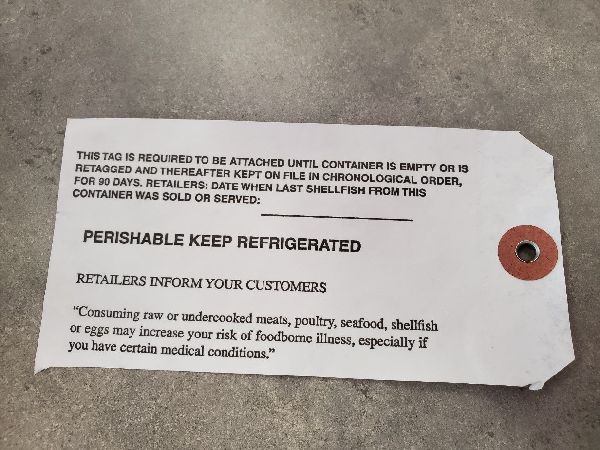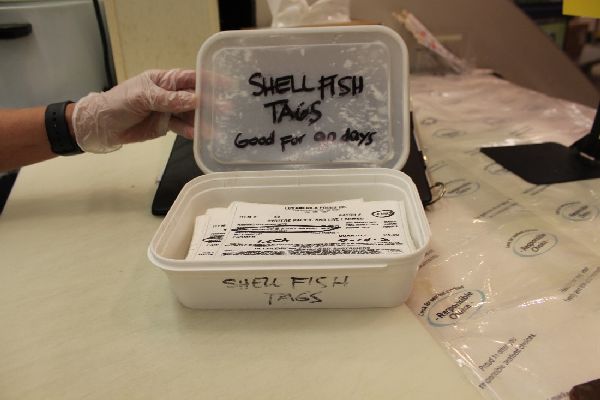Molluscan Shellfish at Retail
Because shellfish is often consumed raw, it must be sourced from clean water under sanitary conditions.
Table of Contents
- Identification of Shucked Shellfish
- Identification of Shellstock
- Repackaging of Product at Food Establishments
- Removal From the Original Container for Display
- Commingling
- Record Keeping Requirements
- Raw Molluscan Shellfish at Certain Facilities
- Practice Good Personal Hygiene
- Preventing Contamination During Storage & Display
- Consumer Self-Service
- Temperature and Time Control
- Sale and Service
- Definitions
Definitions
- Commingle
- To combine shellstock harvested on different days or from different growing areas, or to combine shucked shellfish from containers with different container codes or shucking dates.
- Dealer
- A person certified by the DEC Food Safety and Sanitation Program or certified by another regulatory authority as a shellstock shipper, shucker-packer, re-packer, re- shipper, or depuration processor.
- Disclosure
- A written statement identifying shellfish that is or can be ordered raw, undercooked, or otherwise processed to eliminate pathogens.
- Diseases Communicable by Food
-
- Salmonella
- Shigella
- E coli
- Hepatitis A
- Norovirus
- Highly Susceptible Population
- A group of persons more likely than another group to experience foodborne illness because they are immunocompromised, preschool aged, or older adults, and are obtaining food at a facility that provides services, such as custodial care, assisted living, or health care.
- Molluscan Shellfish
- An edible species of fresh or frozen oysters, clams, mussels, or scallops (except a scallop that consists only of the shucked adductor muscle).
- Reminder
- A written statement concerning risk of consuming raw or undercooked shellfish.
- Shellstock
- Raw, in-shell molluscan shellfish.
- Shucked Shellfish
- Molluscan shellfish that have one or both shells removed.
- Shucker-Packer
- A person certified by the DEC Food Safety and Sanitation Program to shuck and pack shellfish
Identification of Shucked Shellfish
Raw shucked shellfish must be obtained in containers which bear a legible label that identifies the name, address, and certification number of the shucker-packer. The label must also include the "sell by" date for packages of less than one-half gallon or the date shucked for packages larger than one-half gallon.
Identification of Shellstock
Each container of shellstock must have the certified shellfish dealer's tag with required harvest information. The tags must have the following information in order:
- Dealer name, address, and certification number
- Original shipper’s certification number
- The date of harvest
- The harvest location, including water body and specific site designation
- The type and quantity of shellfish
- The following statement in bold, capitalized type: "This tag is required to be attached until container is empty or retagged and thereafter kept on file for 90 days"

Repackaging of Product at Food Establishments
Shellstock may be repackaged in consumer self-service containers if each self-service container is plainly marked with the type and quantity of shellfish, harvest location, date of harvest, and dealer certification number, or otherwise marked with a code that links the product with the tag or label information. Shucked shellfish may not be removed from the original container and repacked by the food establishment into consumer self-service containers.
Removal From the Original Container for Display
For dispensing to the consumer, shucked shellfish or shellstock may be removed from the original container and displayed on drained ice or held in a display container if:
- the required label or tag information is retained and correlated to the dates when the shellfish is sold or served; and
- the products are protected from contamination
Commingling
Commingling of shellstock is prohibited, except containers of shellstock harvested on the same day and from the same growing area may be combined.
Record Keeping Requirements
A shellstock tag must remain on the shellstock container until the container is empty and must be retained for 90 calendar days. The record keeping system for maintaining shellstock tags must be an orderly, chronological system that correlates with the dates of product sale or service and is acceptable to the regulatory authority.

Raw Molluscan Shellfish at Certain Facilities
Unless prepared in response to a specific adult consumer’s request, raw molluscan shellfish may not be served or offered in a ready-to-eat form in a facility that serves a highly susceptible population.
Practice Good Personal Hygiene
- Do not handle ready-to-eat molluscan shellfish with bare hands
- Report symptoms of illness (diarrhea, vomiting, fever, jaundice, sore throat with fever) or diagnosis of a disease communicable by food to the person-in-charge and do not handle food
- Wash hands before and after handling raw molluscan shellfish
Preventing Contamination During Storage and Display
- Store shucked shellfish or shellstock off the floor
- Separate different species of raw, ready-to-eat shucked shellfish or shellstock during storage and display
- Separate raw animal foods from cooked, ready-to-eat food and raw, ready-to-eat shucked shellfish or shellstock during storage and display
- Do not store shellstock below foods that may drip or leak
- If displayed on ice, the ice must be drained
- Rotate from storage to display using the FIFO (First In, First Out) system based on the date of receipt
Consumer Self-Service
Except when offered at a buffet or salad bar, or in individual portions for immediate cooking, raw, unpackaged molluscan shellfish may not be offered for consumer self-service.
Temperature and Time Control
Shucked shellfish or shellstock must be received and held at 41°F.
Sale and Service
A brochure, deli case or menu advisory, label statement, table tent, placard, or other effective means must contain a consumer advisory. The two parts of this consumer advisory are:
- disclosure by either a description of the food, such as "oysters on the half shell" (raw oysters), or identification of the food using an asterisk by the name of the food that refers to a footnote that states the item is raw or undercooked; and
- a reminder that refers to the description or asterisk that states:
- "Regarding the safety of these foods, written information is available upon request."
- "Consuming raw or undercooked meats, poultry, seafood, shellfish, or eggs may increase your risk of foodborne illness." or,
- "Consuming raw or undercooked meats, poultry, seafood, shellfish, or eggs may increase your risk of foodborne illness, especially if you have certain medical conditions."

 Indicates an external site.
Indicates an external site.